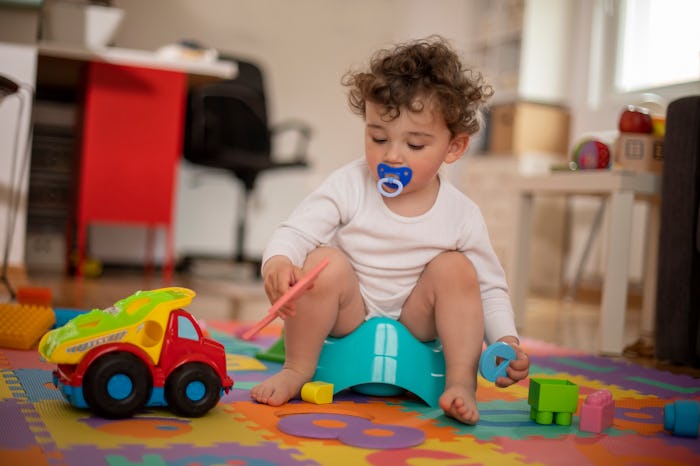Life

Here's How To Talk To Your Kid About Potty Training, According To An Expert
I can remember potty training my son like it was yesterday. After months of displaying interest, on the recommendation of his Montessori teachers, we officially introduced the concept to him over a three-day weekend. Stripped naked for the duration, we let him romp around in the nude until it dawned on him that using the toilet was a better option that tinkling on the kitchen rug. To our great shock, it worked. But each child is different and introducing the whole potty training concept requires finesse and plenty of patience. But how do you talk to your child about potty training? And when should you do it?
“The earlier the better,” Allison Jandu, a full-time Potty Training Consultant, tells Romper. You’ll know it’s time when your child displays certain behaviors. Mimicking your actions (not just for potty-related things), expressing an interest in the bathroom, starting to be able to follow basic direction, and expanding their vocabulary are all good indicators that a child is ready to begin learning about potty training, says Jandu.
“Some key physical indicators would be staying dry for longer stretches during the day or for naps/overnight, asking for a diaper change when they are wet, and hiding to poop,” adds Jandu. “These usually present themselves well after a child is mentally ready to start learning about the process though.”
You can help encourage your child’s interest as well. “I recommend getting a small potty chair around the same time your baby is able to sit up independently without support,” Jandu says. That’s usually between six and 10 months. In fact, she encourages parents to sit them on the training potty in between diaper changes every so often just to get them used to the idea. “You might be surprised and catch a pee or poop in the potty!” she adds. Even if they don’t “go,” however, the concept of the potty won't seem like as much of a big scary change when it comes time to say goodbye to diapers.
For your next step, Jandu recommends familiarizing your child with the potty by using books and videos and, of course, yourself.
“Always start by inviting your child to the bathroom with you when you need to go, and talk them through the steps from start to finish,” Jandu says. “Start with the feelings you get in your body that tell you it's time to go potty, and move through removing pants and underwear, releasing the pee and poop, wiping, redressing, flushing ,washing hands, and how you feel better afterwards!” Jandu adds that by allowing your little one to get involved by flushing the toilet or handing you some toilet paper, you're helping them to learn the steps of potty use and to see that nothing scary goes on in the bathroom.
And most importantly, remember that confidence is built by using positive encouragement. That means avoiding all negative terms when it comes to the bathroom. “Don't refer to it as being yucky, messy, stinky, or dirty,” says Jandu. “It's also important to not pressure the child to use the potty before potty training has started. It is still okay to offer them a turn, but if they don't want to, leave it at that. You'll have plenty of chances to practice once you get rid of those diapers.”
Expert
Allison Jandu, Potty Training Consultant and owner of www.pottytrainingconsultant.com
This article was originally published on